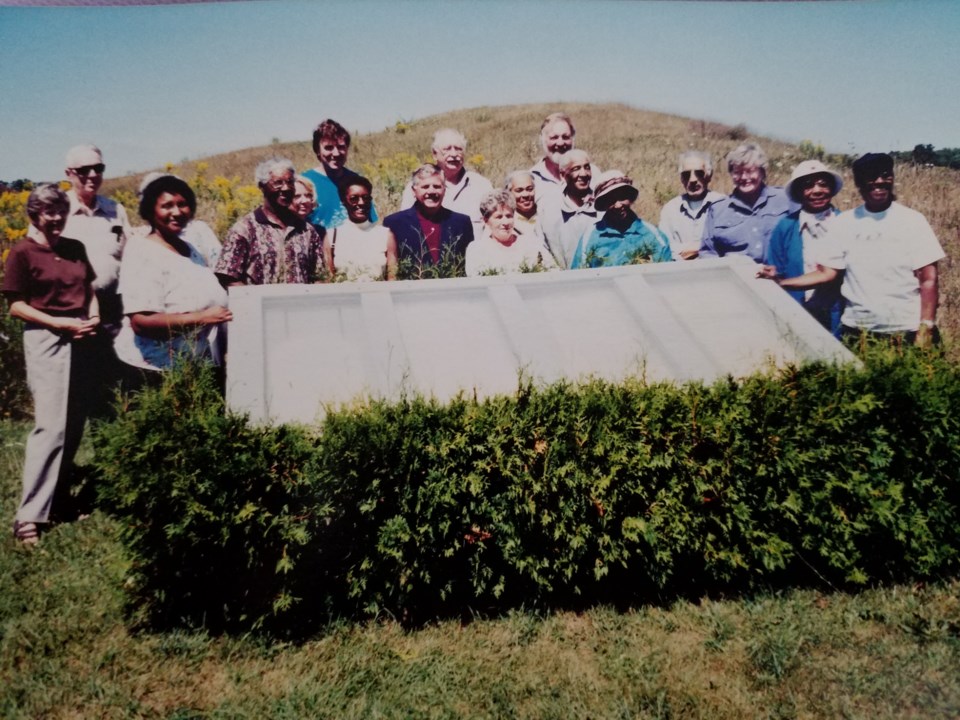After decades of mistreatment and disrespect, the descendants of the Old Durham Road Black Pioneer Cemetery are once again fighting to protect a sacred piece of land where their relatives were once laid to rest.
“We are publicly expressing our opposition to another episode involving the devaluing of the importance of, not only a cemetery burial grounds, but also to the lack of compassion and consideration for the direct descendants and the supportive community that has worked so hard to restore, maintain and promote this lost piece of history,” stated Carolynn Wilson.
Wilson is a Collingwood resident, the past president of the Old Durham Road Black Pioneer Cemetery Committee and curator/co-owner of the Sheffield Park Black History and Cultural Museum.
She explains that Grey County recently began the process of land acquisition for its works department transportation depot along Grey Road 14.
“Grey County council proposes to construct a works department transportation depot near our nationally acclaimed Black cemetery site,” she said. “This plan is detrimental to the physical and historic significance of people of African descent who championed barriers and contributed to our Canadian society.”
The county had been eyeing up 40-acres of land in the municipality of Grey Highlands labelled as lots 21 and 22, on Concession 1 North of the Durham Road, in the geographic township of Artemesia.
The land acquisition arrangement had even been listed on the council’s agenda for the May 27 council meeting but was removed prior to the start of the meeting when county staff and councillors were informed that that specific piece of land was in fact a historic Black Pioneer Cemetery site.
The history of the cemetery site dates back to the 1840s when a new settlement was established in the area. An 1851 census shows nearly every 50-acre lot along the Durham Road was settled by a Black family whose parents were born in the U.S.A. It’s probable many of their parents had been refugees escaping slavery in America.
Over time, those living in the settlement relocated and in the 1930s, a farmer plowed over the cemetery to plant a potato field, breaking and burying several headstones in the process.
In 1980, a number of local residents began the effort to restore the area’s Black history and in 1989 the Old Durham Road Black Pioneer Cemetery Committee was formed.
Descendants of the farmer who had destroyed the cemetery donated a corner of the field to the committee and granted permission to dig through a rock pile on the property.
Through the committee’s efforts, four headstones were found broken and discarded in the rockpile. The names on the stones were confirmed as early Black settlers in the area. They were James Handy and his daughter Ellen, Christopher Simons, and James Washington.
In 1990, the site was commemorated by the honourable Lincoln Alexander, Lieutenant Governor at the time.
Wilson, who is a direct descendant of James Handy, said she was extremely disappointed the county was so oblivious to the site, its history and the efforts the committee has been making over the past several decades.
“These Black Pioneers, their burial places and surrounding sacred grounds deserve respect, honour and preservation,” Wilson said.
“In past years, this cemetery site has already been desecrated and erased. And now, once again, the site is at risk of being dishonoured and its importance minimized by municipal planning and actions,” she continued.
At the county council meeting held on May 27, the associated agenda item was stricken from the agenda, however county CAO Kim Wingrove addressed the issue and offered a public apology for the county’s lack of awareness and consideration.
“On behalf of all of the staff, I want to sincerely apologize to the cemetery committee, the community and the descendants of those who are buried there for the concern and hurt that they are feeling. There should have been consultation with the cemetery committee at the beginning of the process to understand the history,” Wingrove said.
Wingrove also apologized to the council members for “failing to anticipate these concerns.”
“As staff, we were not aware of the significance of the site or the existence of the committee who cares for it, and we should have been,” she added.
Wingrove along with Warden Selwyn Hicks and Grey Highlands Mayor Paul McQueen all reached out to the committee to offer their apologies and scheduled a meeting with committee members.
“I hope we can use newfound understanding to work together,” Wingrove added.
However, Wilson says the complete lack of awareness about this site and the importance of preserving it does not go unnoticed.
“The municipal officials are portraying a disregard of the impact this action will have on the historic value of the contributions of the Black community to this particular area and to Canada,” she said.
The committee is calling on members of the public to share letters of support with the County Warden in order to stop this and any future attempts to encroach on the sacred site.
“This is big because our tombstones remain buried in this entire area around the cemetery and possibly under the road,” Wilson added.
For those looking for more information on the Old Durham Road Black Pioneer Cemetery, Wilson points to the national film Speakers For The Dead and encourages any and all interested parties to visit the Sheffield Park Black History and Cultural Museum.
The site of the cemetery can also be visited today in Priceville along Old Durham Road south of Highway 4 at the five-point intersection.
Wingrove noted that county staff will be presenting a staff report on the cemetery property and control of the property at a future council meeting.
With files from Erika Engel.
